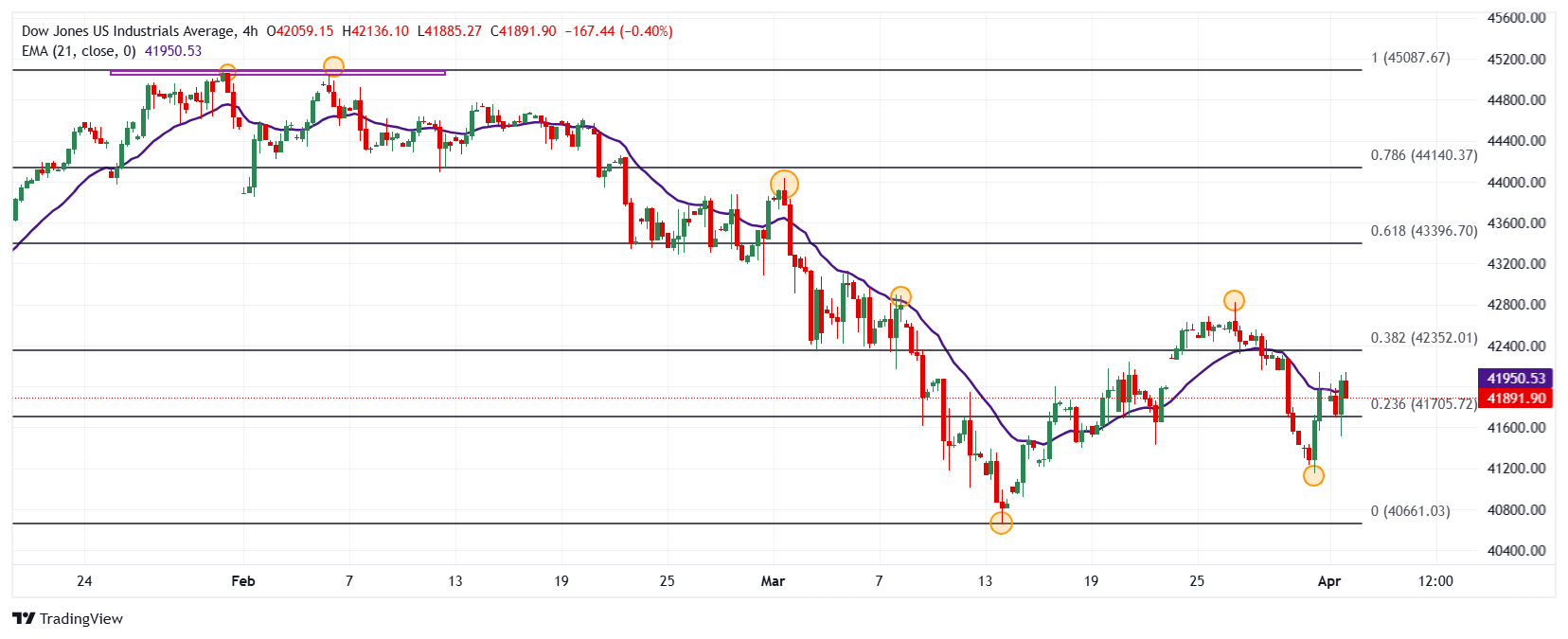- The Dow Jones wins 0.10% daily, operating at this time over 42,020.
- The Nasdaq 100 rebounds 0.50% today, with Tesla (TSLA) leading the profits.
- The S&P 500 rises 0.22% on Tuesday, signing its second consecutive day with profits.
- The ISM manufacturing PMI is located at 49 points in March, below the estimates of analysts.
- The focus of investors remains in the imposition of reciprocal tariffs by Donald Trump, tomorrow.
The Dow Jones established a daily minimum in 41,509, finding buyers who took the index to a daily maximum in 42,136.
The Dow Jones industrial average began negotiations in 41,866, while the Nasdaq 100 technological index began operating in 19,227. The S&P 500 opened in 5,593, reaching maximums of March 28 in 5,647.
The Dow Jones remains in a positive area animated by Nike and Amazon
The Dow Jones index rises 0.10% in the day, currently quoting at 42,020, spinning two consecutive days up.
Nike (NKE) shares rise 2.27% today reaching March 28 at $ 65.04. In the same tune, Amazon titles (AMZN) earn 1.50% on Tuesday, reaching maximum two days in 193.93 $.
The main stock market indices have profits today, in the midst of commercial tensions due to the imposition of reciprocal tariffs by Donald Trump, which I know that they enter into force tomorrow.
Tesla and Microstrategy Incorporated lead the profits in Nasdaq 100
The Nasdaq 100 technological index wins 0.50% on Tuesday, reaching maximum of March 28 on 19,352.
Tesla (TSLA) values rise 5.63% daily, signing their second consecutive rise, reaching maximum of two days in 277.45 $.
Following the bullish perspective, Microstrategy Incorporated (Mstr) rebukes 4.18% today, visiting maximums of March 28 at 307.60 $.
The Nasdaq 100 extends the profits on Tuesday, keeping in positive terrain in tune with the main stock market rates.
The S&P 500 lifes up to the US key.
The manufacturing activity of the United States presented a contraction in March to be located at 49 points from 50.3 observed in February, this figure is less than 49.5 expected by analysts.
On the other hand, the US Labor Statistics Office announced that the Jolts work and labor rotation survey registered 7,568 million positions in February, below the estimated 7.63 million and the previous 7,762.
In this context, the S&P 500 records a gain of 0.22% in the day, reaching maximum of March 28 in 5,647.
Investors concentrate their attention in the entry into force of reciprocal tariffs imposed by Donald Trump, scheduled for tomorrow.
Technical Analysis of Dow Jones
The Dow Jones established a short -term support given by the minimum of March 31 in 41,153. Upwards, the closest resistance is observed in 42,897, maximum of March 7 in convergence with the exponential mobile average of 21 periods. The following key resistance is 44,033, a pivot point of March 3.
4 -hour graph of Dow Jones

Dow Jones Faqs
The Dow Jones Industrial Avenge, one of the oldest stock market indexes in the world, consists of the 30 most negotiated values in the United States. The index is weighted by the price instead of capitalization. It is calculated by adding the prices of the values that compose it and dividing them by a factor, currently 0.152. The index was founded by Charles Dow, also founder of the Wall Street Journal. In recent years it has been criticized for not being sufficiently representative, since it only follows 30 companies, unlike broader rates such as S&P 500.
There are many factors that promote the Dow Jones Industrial Average (DJIA) index. The main one is the added performance of the companies that compose it, revealed in the quarterly reports of business benefits. The American and world macroeconomic data also contribute, since they influence investor confidence. The level of interest rates, set by the Federal Reserve (FED), also influences the DJia, since it affects the cost of credit, on which many companies depend largely. Therefore, inflation can be a determining factor, as well as other parameters that influence the decisions of the Federal Reserve.
Dow’s theory is a method to identify the main trend of the stock market developed by Charles Dow. A key step is to compare the direction of the Dow Jones Industrial Avenge (DJIA) and the Dow Jones Transportation Average (DJTA) and just follow the trends in which both move in the same direction. The volume is a confirmation criterion. The theory uses elements of maximum and minimum analysis. Dow’s theory raises three phases of the trend: accumulation, when intelligent money begins to buy or sell; Public participation, when the general public joins the trend; and distribution, when intelligent money abandons the trend.
There are several ways to operate with the DJ. One of them is to use ETF that allow investors to negotiate the DJ as a single value, instead of having to buy shares of the 30 companies that compose it. An outstanding example is the SPDR Dow Jones Industrial Avenge ETF (day). Future contracts on the DJ allow the specular operators about the future value of the index and the options provide the right, but not the obligation, to buy or sell the index at a predetermined price in the future. Investment funds allow investors to buy a part of a diversified portfolio of DJ values, which provides exposure to global index.
Source: Fx Street
I am Joshua Winder, a senior-level journalist and editor at World Stock Market. I specialize in covering news related to the stock market and economic trends. With more than 8 years of experience in this field, I have become an expert in financial reporting.







